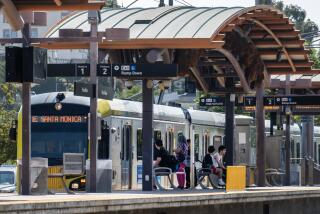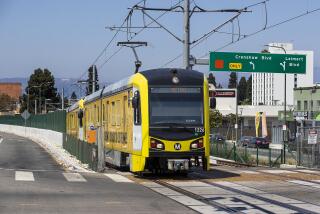Extension of Beeline Shuttle Sought
- Share via
A petition has been sent to Glendale city officials asking that the 4-month-old Beeline shuttle-bus service, which has had trouble attracting riders, be expanded beyond downtown.
The petition, mailed to Glendale City Councilman John Day, seeks the addition of more than a mile to the Beeline’s route, expanding it into residential areas of northern Glendale.
The petitioners are asking that the shuttle service include stops along Brand Boulevard and Central Avenue as far north as Mountain Street.
No Supermarket Stops
According to the petition, the request is being made on behalf of senior citizens who are upset because “the Beeline bus doesn’t go anywhere near a supermarket” and because “there are many people that don’t have transportation that live on the north side of Glendale.”
The petition was signed by 284 persons who claimed to be Beeline users. It was mailed last month without a return address and did not identify its author, Day said in an interview.
The shuttle now travels in two directions along a J-shaped route bounded by Arden Avenue to the north and Harvard Street to the south. The petition proposes extending the northbound route up Brand Boulevard to Mountain Street, where it would make a loop to Central Avenue, then head to Stocker Street before returning to Brand to continue on its downtown route.
The petitioners want six stops placed along the proposed extension, including stops at two Ralphs supermarkets. One of the supermarkets is at Glenoaks and Brand boulevards and the other is at the corner of Stocker Street and Central Avenue.
‘On the Front Burner’
Day said he will put expansion of the Beeline route “on the front burner” now that the municipal election is over. “I am in favor of expanding the service area of the Beeline to meet the needs and wishes of the people up there in north Glendale,” said Day, who was reelected to his City Council seat Tuesday.
The Beeline route was designed to help relieve congested traffic in the city’s developing downtown by servicing the civic center, business district, Galleria shopping mall and medical offices. The mini-buses make 37 stops along a three-mile route, but none at a shopping center with a supermarket.
Day, who is also a director of the Southern California Rapid Transit District, said he forwarded the petition to City Manager James Rez. Day said the petition was returned to him with the reply that those seniors who need transportation to grocery stores could call Dial-A-Ride, a free van service funded by the federal government, that picks up senior citizens and the disabled at their homes upon request.
“That’s not satisfactory to me, and I’m going to pursue it,” Day said of Rez’s reply. The Beeline, Day added, should meet the needs of its users, and “obviously we are not meeting the need for grocery shopping with the present route.”
Problems of Expansion
When asked about the petition, Rez said there are problems with expanding the Beeline route. He said the city didn’t want to duplicate any RTD service or to duplicate Dial-A-Ride.
“If only two or three people want to go to a particular location, it’s counterproductive when you have a Dial-A-Ride service,” Rez said.
Dial-A-Ride takes about five to seven people a week on grocery shopping trips, said Dana Hampton, the service’s manager. The service could accommodate more people, Hampton said, but it doesn’t get that many requests for trips to the supermarket. Dial-A-Ride is used mainly to travel to medical offices, nutritional programs, hospitals, Social Security offices and the homes of families and friends, Hampton said.
Rez said a number of changes for the Beeline have been suggested by riders and by business people and that the city will “undoubtably make some changes.” But that won’t be for at least another two or three months, Rez said. The city, he said, is waiting to give the Beeline “a fair shake” and to compile more data on where people are boarding and disembarking.
Encouraging Riders
Councilman Day said he feels that expansion of the Beeline service could help the struggling bus line, especially since a large number of its passengers are senior citizens. “There has not been an overwhelming number of riders on the Beeline,” Day said. “We may have to do something to encourage people to use it. Extending it would be one thing--we could pick up more passengers.”
The shuttle service began operating in mid-December and charges 25 cents a ride. It is subsidized by part of the city’s income from Proposition A, the half-cent sales tax levied in Los Angeles County to help finance transportation projects. The service is being operated by Pacific Busing Inc. under a one-year contract with the city.
Ridership on the fleet of four Beeline buses, which can carry up to 19 passengers, has not kept pace with the city’s projection of 80,000 riders annually. To meet that goal, about 6,700 passengers would have to board the Beeline monthly. But so far, with the exception of December, when free rides attracted more than 4,000 passengers, the Beeline has had fewer than 3,000 riders a month.
The number of Beeline riders dropped off 50% when the free-ride period ended in January. According to figures provided by Pacific Busing, there has been a slight increase in riders over the past three months, from 2,266 passengers in January to 2,617 passengers in March.
Promotional Efforts
City officials attribute the low ridership to the community’s unfamiliarity with the shuttle system. “I knew it was going to take a large marketing effort, but I didn’t realize it was going to take as large an effort as what is really needed,” said Kerry Morford, the Public Works Division official in charge of the Beeline.
The city launched a bus token program in February that was intended to get downtown businesses to encourage their patrons to use the Beeline. Under the program, the city sells bus tokens to merchants at a discount price for free distribution to their passengers. But so far, Morford said, there have been only three participants: the Glendale Chamber of Commerce, Glendale Oral X-ray Lab and the Glendale Eye Medical Group.
The token program has gotten off to a slow start because “we have not aggressively pushed the token program on business folks,” Morford said.
He said letters sent out to businesses explaining the program may be followed up soon by visits from city representatives to stimulate interest in the token program.
More to Read
Sign up for Essential California
The most important California stories and recommendations in your inbox every morning.
You may occasionally receive promotional content from the Los Angeles Times.













